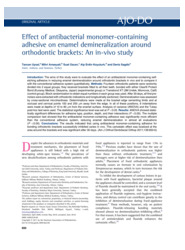Effect of antibacterial monomer-containing adhesive on enamel demineralization around orthodontic brackets: An in-vivo study
-
Eser Sahibi
TANCAN UYSAL
-
Tür
Makale
- Yayın Tarihi 2011
- DOI Numarası 10.1016/j.ajodo.2009.06.038
-
Yayıncı
American Journal of Orthodontics and Dentofacial Orthopedics
- Tek Biçim Adres Http://hdl.handle.net/11469/176
- Konu Başlıkları Antibacterial monomer-containing adhesive
Introduction: The aims of this study were to evaluate the effect of an antibacterial monomer-containing selfetching
adhesive in reducing enamel demineralization around orthodontic brackets in vivo and to compare it
with the conventional adhesive system quantitatively. Methods: Fourteen orthodontic patients were randomly
divided into 2 equal groups; they received brackets fitted to all their teeth, bonded with either Clearfil Protect
Bond (Kuraray Medical, Okayama, Japan) (experimental group) or Transbond XT (3M Unitek, Monrovia, Calif)
(control group). Block randomization to obtain equal numbers in each group was used. After 30 days, all first premolars
were extracted with orthodontic indications and longitudinally sectioned. Demineralization was assessed
by cross-sectional microhardness. Determinations were made at the bracket edge cementing limits and at
occlusal and cervical points 100 and 200 mm away from the edge. In all of these positions, 6 indentations
were made at depths of 10 to 90 mm from the enamel surface. Analysis of variance (ANOVA) and the Tukey
post-hoc test were used. The statistical significance level was set at P\0.05. Results: ANOVA showed statistically
significant differences for adhesive type, position, depth, and their interactions (P\0.05). The multiple
comparison test showed that the antibacterial monomer-containing adhesive was significantly more efficient
than the conventional adhesive system, reducing enamel demineralization in almost all evaluations
(P \0.05). Conclusions: The results indicated that using antibacterial monomer-containing adhesive for
bonding orthodontic brackets successfully inhibited caries in vivo. This cariostatic effect was localized at the
area around the brackets and was significant after 30 days.


 Tam Metin
Tam Metin

